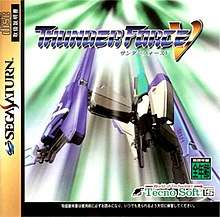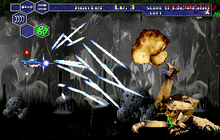Thunder Force V
Thunder Force V[lower-alpha 1] is a 1997 Japanese side-scrolling shooter video game developed by Technosoft for the Sega Saturn. It is the fifth game in the Thunder Force series. Unlike previous games in the series, Thunder Force V uses polygons to model the larger enemy ships and some of the scenery, in addition to sprites.[1] In 1998, Thunder Force V was ported to the PlayStation as Thunder Force V: Perfect System.[2]
| Thunder Force V | |
|---|---|
 Sega Saturn cover art | |
| Developer(s) | Technosoft |
| Publisher(s) |
|
| Director(s) | Naosuke Arai |
| Series | Thunder Force |
| Platform(s) | Sega Saturn, PlayStation |
| Release | Sega Saturn
|
| Genre(s) | Horizontal-scrolling shooter |
| Mode(s) | Single-player |
Gameplay

Thunder Force V is a horizontal-scrolling shooter video game. It is presented from a 2.5D perspective, with environments rendered in 3D and gameplay taking place on a 2D plane. The player controls a starship named the Gauntlet in its mission to destroy the Guardian, a supercomputer that became rogue after deciphering the code of a space vessel. There are seven levels total, and the first three can be selected in any order. Levels scroll automatically, and the player is given free movement. Its gameplay is similar to its predecessor, Thunder Force IV; players must destroy constantly-moving formations of enemies and dodge their projectiles and incoming obstacles. A boss concludes the end of a stage.[3]
As in previous Thunder Force games, the player has a special weapon named the "CRAW" that emits additional firepower and absorbs enemy shots. Thunder Force V allows for three CRAWs to be used instead of two like its predecessors, and will remain on the screen for a finite period of time that allows the player to recollect them.[4] The CRAWs can also be combined with the player's currently-selected weapon to create a more powerful version of it called an "Over Weapon". Over Weapons can be used for a limited amount of time before they revert to their original state. Creating Over Weapons uses up the CRAW's energy, which is indicated by its change in color. Energy can be replenished by collecting additional CRAWs or by waiting for them to recharge.
Release
Thunder Force V was released in Japan for the Sega Saturn on July 11, 1997.[5] There were two retail versions, the normal pack, and a special pack which contained a remix music CD of various Thunder Force music entitled Best of Thunder Force,[6] which was later released separately. The Saturn version was never released outside Japan. Sega Europe took a preproduction version under consideration, and decided against publishing the game.[1] Electronic Gaming Monthly urged readers to tell Sega of America to release the game in the United States,[4] but it was never released there either.
Thunder Force V was ported to the PlayStation and released in 1998 as Thunder Force V: Perfect System.[7] It was published in North America by Working Designs under the SPAZ label. The PlayStation version features additional levels, high-resolution artwork, CG rendered movie sequences, and a time attack mode.[7]
Reception
| Reception | ||||||||||||||||||||||||
|---|---|---|---|---|---|---|---|---|---|---|---|---|---|---|---|---|---|---|---|---|---|---|---|---|
| ||||||||||||||||||||||||
Next Generation reviewed the PlayStation version of the game, rating it two stars out of five, and stated that "Gameplay is beyond idiotic, but at least it is difficult. If there is a saving grace here, then it is this: Thunderforce takes you back to a time when games weren't as good as they are now."[13]
James Mielke from GameSpot gave the PlayStation version a review score of 8.2/10, stating, "easily as good as Raystorm or G-Darius and tough competition for Einhander, Thunder Force V is a shooting fan's dream."[7]
Japanese gaming publication Famitsu gave the Sega Saturn version a 28 out of 40, and the PlayStation version a 31 out of 40 score.[5]
Retrospectively in 2007, Rob Fahey of Eurogamer said that while it wasn't nearly as refined or "utterly fantastic" as Einhänder or Radiant Silvergun, Thunder Force V was still a good shooter with well-implemented mechanics. Fahey particularly praised the CRAW for being the game's "hook", and also liked its level design and "perfectly-tuned" boss fights. He described it as being: "A very solid shooter, in other words, which deserved far more credit than it received - not least because any shooter with bosses called Deep Purple and Iron Maiden is alright in our book".[15] In 2010, Hardcore Gaming 101's Paul Brownlee said that Thunder Force V had a great soundtrack and good gameplay, but was slightly hindered by visuals and 3D models that didn't age well. He argued that one of the game's strong points was its boss fights for their cool-looking designs and accompanying music tracks, some of which are based on those from previous Thunder Force games. Brownlee compared the two versions of the game, and claimed that neither of them were better than the other; he said that while the Saturn version had more detailed backdrops and the PlayStation version had better textures, neither of them had good graphics in the long run.[16]
Notes
References
- Leadbetter, Rich (September 1997). "Thunder... Thunder... Thunder: Thunderforce - Ho!". Sega Saturn Magazine. No. 23. Emap International Limited. pp. 50–52. Retrieved November 4, 2019.
- "サンダーフォースV パーフェクト システム [PS] / ファミ通.com". www.famitsu.com. Archived from the original on 2016-02-12. Retrieved 2018-07-27.
- Thunder Force V: Perfect System (PDF). USA: Technosoft. 31 August 1998. Archived from the original (PDF) on 24 May 2020. Retrieved 24 May 2020.
- "Thunder Force V: The Classic 16-Bit Shooter Returns". Electronic Gaming Monthly. No. 100. Ziff Davis. November 1997. p. 58.
- "サンダーフォースV [セガサターン] / ファミ通.com". www.famitsu.com. Archived from the original on 27 July 2018. Retrieved 27 July 2018.
- "Behind the Screens: The Special Pack". Electronic Gaming Monthly. No. 100. Ziff Davis. November 1997. p. 58. Italic or bold markup not allowed in:
|magazine=(help) - Mielke, James (31 August 1998). "Thunder Force V Review". GameSpot. CBS Interactive. Archived from the original on 18 January 2009. Retrieved 4 November 2019.
- "Archived copy". Archived from the original on 27 November 2017. Retrieved 11 October 2017.CS1 maint: archived copy as title (link)
- Lomas, Ed. "Mini Reviews - Thunder Force V" (PDF) (190). United Kingdom: Future Publishing. Computer and Video Games. p. 78. Archived from the original (PDF) on 24 May 2020. Retrieved 24 May 2020.
- "Viewpoint - Thunder Force V" (Volume 5, Issue 9). Metropolis Media. GameFan. September 1997. p. 27. Retrieved 24 May 2020.
- "Thunder Force V: Special Pack (Import) Review". GameSpot. CBS Interactive. Retrieved 4 November 2019.
- Nelson, Randy (13 November 1998). "Thunder Force V". IGN. Archived from the original on 27 September 2016. Retrieved 31 March 2020.
- "Finals". Next Generation. No. 46. Imagine Media. October 1998. p. 128.
- "NAVE - SATURNO/PLAYSTATION: Thunder Force 5". Acao Games. No. 131. September 1998. p. 47.
- Fahey, Rob (7 August 2007). "Thunder Force V". Eurogamer. Gamer Network. Archived from the original on 2 October 2019. Retrieved 24 May 2020.
- Brownlee, Paul (17 April 2010). "Thunder Force V". Hardcore Gaming 101. Archived from the original on 23 October 2019. Retrieved 24 May 2020.